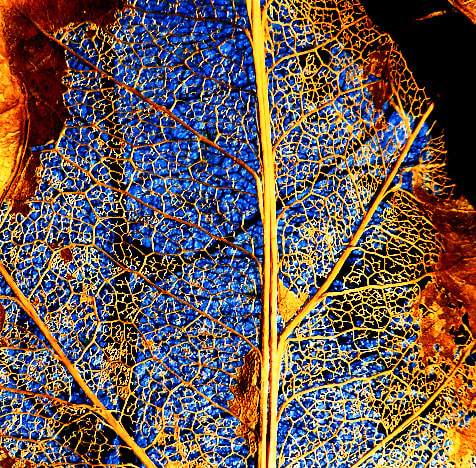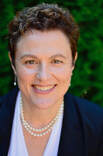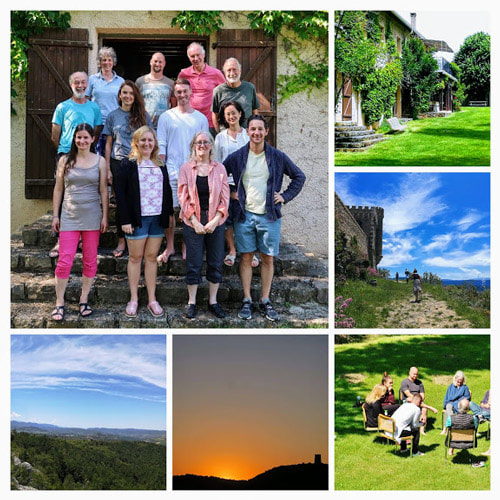 I was in France this September to help with staffing at the two Choose Again Las Labadous workshops. I’d love to share some thoughts and images that have stayed with me. My time in France was beautiful, scary, frustrating, joyful, challenging, heart-opening and mind-opening. Let me tell you a little more. The train to Las Labadous Paris: Montpellier Station. The start of my trip from Paris to Carcasonne. Busy, rushing and crowds of people at the station. Everyone seemed to know where they were going and where to find their train. I did not. Frustration, fear and anxiety which turned to: Resting quietly on the train, deep appreciation as the countryside unrolled. Grassy hills, fences, cows, small towns, ancient houses, tiny villages. Bits and pieces of old stone fortresses and fences. Small, prosperous looking dairy and fruit farms. Grapes, healthy green vines winding skyward. A feeling of years and centuries past. Arrival in Carcasonne: a loving welcome from Christine and Martin, two Choose Again friends, also the owners and hosts and part of staffing at the Las Labadous retreat. Driving through more green fields, country roads and roundabouts, winding up and then down again as we headed into the valley where Las Labadous rests. Las Labadous Retreat Centre Nestled in a quiet corner of the Aude valley. Peaceful. Large trees of many different shapes and species. Sheltering with a kindly presence. The foothills of the Pyrenees resting in the distance: a feeling of ancient grace. Above us, on one side, an old, tiny town: Rennes-le-Chateau. Remnants of the castle, stories of Mary Magdalene travelling and settling. Softness in the air. A kindly presence holds all in place. On the far side of the valley, and well above us, the remnant another castle, Chateau Bezu. Perching high on a mountain, with the barest remains of a tiny chapel. Soft green trees and fields. Mystery clinging to life on the steep edge of a mountain. The heart of the retreat: Participants (clients and staff) from a variety of countries in Europe, and the US and Canada. Some arrived with happiness, others came in the company of fear and self-condemnation. A few felt they had been lax in their inner work, and were discouraged, looking to re-orient themselves back into clarity and peace. Others came with a pleasant sense of anticipation, looking forward to deepening the well-being that the Choose Again work had brought them. Staff were joined in one purpose: to be of service, knowing that our minds would be healed more deeply as we interacted in service and love with others. In the retreats, there was honesty, even urgency at times, as people spoke of their challenges, shared in a heart-felt way of their longing for peace. Some spoke in anger or fear as they mentioned grievances they could not forget and the love they could not find. This was the first step – next came the powerful and sometimes joyful desire to take full responsibility for the experience personal suffering. Followed by an equally strong desire to look at it clearly in order to process and release the underpinning beliefs. I’m guilty I’m unlovable I’m alone, I’ve been abandoned. Over and over there was determination far beyond mere willingness, to release the habit of the same few beliefs that the ego builds a life on. I heard different words, different languages sometimes, spoken perhaps with tears, anger or laughter, but always the same intention: letting it go, letting it all go. I saw people exploring peace, feeling the strength of the goodness within. Keeping it company until it felt like a friend. Daring to find a home in the love that stays steady on shifting sands. Time moved quickly, and it moved slowly, but all was done that needed to be done. Healing flowed in and through and around each of us, weaving its way through hearts and minds. Each received as they could, and took away what best suited their purpose. After the last workshop ended, I was relaxing in my room, enjoying a final night at Las Labadous. Savouring the feel of all that had gone before and beginning to think about my journey home – its possibilities and unknowns, as I continued on. Heading home: A couple of days later at Charles de Gaulle airport: An overwhelming crush of people, slowly stopping and starting again as we were moved through security. Stern looking agents and officers, tired looking airport employees, herding us into line. Finally, through it, out the other side and into a glorious and quiet corner of Starbucks, near the gate my plane would be leaving from. I sipped my coffee, relaxed into the couch I was sitting on. I picked up my book, and I read this: “…………Healing is release from the fear of waking and the substitution of the decision to wake. The decision to wake is the reflection of the will to love, since all healing involves replacing fear with love………………”. ACIM The will to love……yes. The workshop, in a nutshell. -Dawn Green
0 Comments
We have revived an old document created by Diederik Wolsak showing a simple flowchart of the Six Steps process. For those of us who are visual learners, this is a helpful tool! Download a free copy here:
Interested in learning to practice the Six Steps for yourself? Check out our half-day introductory intensives and experience this work for yourself.
"What is meaningless is neither good nor bad. Why, then, should a meaningless world upset you? If you could accept the world as meaningless and let the truth be written upon it for you, it would make you indescribably happy. But because it is meaningless, you are impelled to write upon it what you would have it be. It is this you see in it. It is this that is meaningless in truth. Beneath your words is written the Word of God. The truth upsets you now, but when your words have been erased, you will see His. That is the ultimate purpose of these exercises." Dear Friends, I have been using the above quote from lesson 12 (ACIM) as a foundational teaching in circles and sessions lately. I have come to realize (yes, I am slow) that what we learned in the 1930's, and the last 5 or so years again, is that a repeated message, true or false, becomes true in the minds of the reader over time. The message I glean from the above quote is that I have to train the 'decision maker' to step up and recognize that the information coming from the ego will at all times be consistent with my core beliefs. Once that recognition is accepted I then have to learn to turn to the Loving Self, patiently waiting within, and ask: "Is there another way of seeing this?" I, the ego, has an immediate assessment ready but that information will never lead me to a peaceful approach to whatever seems to be happening. When I use my definition of Love - joyful surrender to what Is - I am speaking to just that process: surrender to the interpretation the Self is at all times ready to provide. The reason that is inevitably a 'joyful surrender' is that the Self will always provide an interpretation that leads to healing. The meaning that the Self gives to whatever seems to be happening is always one that would make me "indescribably happy". There is something astonishing and enticing in those words: "indescribably happy". Who would not want that? Well, very few it turns out. The resistance to ignoring the ego's judgment is tenacious. The ego is the only thing 'I' (the ego) trusts, what a surprise. There is also a strange reaction to the idea of being 'indescribably happy' and that is the ego invariably will say: "that would be boring" and then the old red herring of constant sunshine being boring is tossed on the table. "I like my feelings, just like I like the seasons." And, then, when asked: "If you had the choice to be gloriously happy right now, or stay in your current state of depression (or anxiety, or rage, or worry), a person will always answer that happiness would naturally be preferred, just not constantly. It re-boggles the pre-boggled mind. Give yourself the discipline to practice the above paragraph, it will change the way you react to any potential upset and is a perfect adjunct to the Six Step Process. A wonderful New Year's resolution would be: "I am going to question everything I now believe to be true and I am going to ask the Guide within to help me see what IS True under all circumstances." Love, Diederik  Diederik Wolsak is the Founder and Program Director of Choose Again and author of Choose Again Six Steps to Freedom. Are you feeling stuck in unwanted patterns of emotions and behaviour? Could it be that your coping skills are keeping you there? There is a downside to coping. By facing emotions head on, rather than pushing them away you can become unstuck and actually thrive. I’m going to point to a transformative way of dealing with difficult emotions. At this challenging time in human history we’ve all needed to fall back on our coping skills to get us through unusual circumstances such as lockdowns, zoom overload, or working from home without a dedicated office space. These situations have given rise to feelings of isolation, overwhelm, anxiety and countless others. Coping is how we deescalate a situation or turn down the volume on unwanted emotions. Whether it is counting to ten to avoid bursting with anger, downing a glass of wine after a stressful day of working from home, or binging on Netflix to quiet anxiety over endless bad news, we have found ways to get by. The problem is that this is a temporary solution and the root cause of our emotional reactions has not been tackled. There is a downside to merely ‘coping’. The same emotions will keep coming up and the pattern is held in place. There is a better way that will allow you to thrive rather than just survive. Our emotions can help us get to the root cause of our upsetting feelings and heal them there where it can actually produce lasting change. That’s where the Choose Again Six Steps to Freedom come in. SOLUTION Here are the necessary steps (for the complete version see Choose Again Six Steps to Freedom by Diederik Wolsak):
Whenever we are experiencing an emotion (other than love, joy or peace), we can be considered to be upset. Our emotional reactions are driven by the negative beliefs that we formed about ourselves in early childhood events which we have experienced as being traumatic and these are stored in our systems. We can therefore feel our way back in our memories to find the initiating incidents and the beliefs about ourselves we made up as a result. It is not true that you are unlovable because you broke your grandmother’s favourite vase or didn’t win the spelling Bee. We can forgive ourselves for making up negative beliefs that were never true and remind ourselves of our Inherent Worth. Reassure yourself that nothing you do or say or did or said can change the truth of that. This realization frees us and changes our behavior patterns. You will find that you are no longer triggered to the same degree when your adverse childhood experience is reinterpreted in this way.
SUMMARY Coping skills by nature help us to avoid looking at root cause of emotional reactions. There is a time and place for them – they allow us to survive, but to thrive you can revisit painful emotions and use them to heal old limiting beliefs that you made up as young children. The Choose Again Six Steps to Freedom provides a proven path to calm and self-realization. To recap, here are the steps:
CONCLUSION Turn surviving into thriving in any situation by welcoming the emotions that coping skills downplay. By following emotions into memories (using the Six Steps to Freedom), you can go to the root cause of the discomfort that COVID-19, relationship problems, climate change, and other challenging situations seem to provoke in us. Practicing the Choose Again Six Step process regularly will lead to the ability to stay calm rather than needing to ‘cope’. Helpful resources: Choose Again Six Steps to Freedom by Diederik Wolsak RPC, MPCP Choose Again online Circles Mastering the Six Steps online course  Everything is a Neutral Fact Lessons you can share with your kids or with your inner child. By Anne Andrew #1 Everything is a neutral fact These are just facts:
There’s nothing inherently upsetting about these facts, but we may feel good or bad about them because of our thoughts about them. The good news is that we can change our thoughts – we are in control of our thoughts. That’s pretty good to know! Facts have no emotion attached to them in and of themselves. However, we react to facts based on our beliefs (ideas) about ourselves. It is your thoughts that cause you to feel bad. So, if mom or dad yells at you, you are likely to be upset – not by the yelling itself, but by what you think it means about you. It is just a fact that the person in front of you is going red in the face, looking angry and speaking at a higher volume than usual, but you are upset about this if you have a made-up idea about yourself that is being triggered. The following made-up ideas would likely be triggered by this scenario: I’m not safe I’m bad I’m guilty I’m not loveable I’m powerless It is almost certain that you have all these beliefs and more. The reason is that you were a tiny being when you came into the world and you are looked after by big people who share these made-up ideas. It can be terrifying at times! It is important to know that these ideas are not true. Action Steps: List your ‘triggers’ as statements of fact. So, for example, if you were upset by something your friend said to you or the reaction of your sister, or something you did that was clumsy, just write: My sister laughed when I broke my favorite model airplane. My friend called me stupid (or whatever it was). I spilled juice on the carpet. Now look at the list and see that when these are stated as facts they no longer have the same emotional charge. Wanting things to be different than they are is painful. By stating facts, you now know that this thing happened. Wishing that it didn’t doesn’t help at all. Actually, the fact that the trigger event happened can be a really good thing because if you have an emotional reaction to any event (or fact) you’ll know that you have an idea about yourself that isn’t true. You can learn how to find and fix those mistaken ideas. Eventually you may even be able to welcome triggers! We’ll work on that another time. Anne Andrew Anne Andrew is the author of What They Don’t Teach in Prenatal Class: The Key to Raising Trouble-Free Kids and Teens and teaches workshops for parents in person and online. You can find this blog and other teachings here: https://www.anneandrew.com/blog/choose-again-minis-lessons-you-can-share-with-your-kids-or-with-your-inner-child
|
Categories & Authors
All
Archives
November 2022
|
||||||
Read an independent evaluation of our program |
| ||||||
QUESTIONS? |
GET daily INSPIRATION TO YOUR EMAIL |










 RSS Feed
RSS Feed